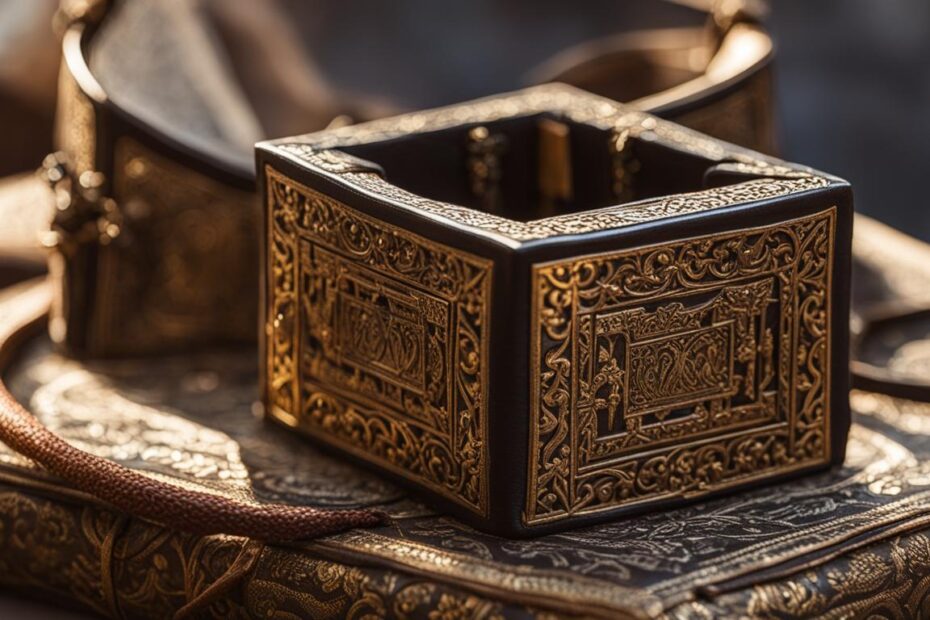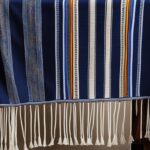Tefillin, also known as Phylacteries, are small black boxes paired with leather straps that hold deep spiritual significance in Judaism. They are worn by Jews during weekday morning prayers as a way to connect with their heritage and engage in a timeless tradition. The boxes are placed on the arm and forehead, symbolizing the binding of one’s actions and thoughts to God and His teachings. Scrolls with passages from the Torah are enclosed in each box, reminding Jews of their obligations to God and the significance of their faith. Wearing Tefillin during prayers enhances one’s spiritual practice, serving as a powerful reminder of God’s presence and fostering a more mindful and dedicated approach to worship.
Key Takeaways:
- Tefillin are small black boxes with leather straps worn by Jews during weekday morning prayers.
- They symbolize the binding of one’s actions and thoughts to God and His teachings.
- Tefillin contain scrolls with passages from the Torah, reminding Jews of their obligations to God.
- Wearing Tefillin enhances spiritual practice and fosters mindfulness during worship.
- Tefillin have a long-standing tradition in Judaism and hold deep religious significance.
Historical Background of Tefillin
Tefillin, also known as Phylacteries, have a rich historical background deeply rooted in Jewish tradition. These sacred tools have been mentioned in the Torah, dating their origin back to biblical times. Throughout history, Tefillin have evolved in design and practice, showcasing the adaptability and enduring significance of this ancient ritual.
In various Jewish communities, there may be variations in the customs and styles of Tefillin, reflecting the diversity within the religion. However, despite these variations, the essence of Tefillin remains constant, symbolizing the unwavering commitment to God’s commandments and Jewish identity.
Made from specific materials, such as leather from kosher animals, Tefillin undergo meticulous craftsmanship to ensure their sanctity. The artistry involved in their construction reflects the sacred value placed on these tools, making each pair unique and spiritually significant.
| Variations Among Sects | Materials Used | Changes Over Time |
|---|---|---|
| The design and usage of Tefillin may vary among different Jewish sects. | Specific materials, such as leather from kosher animals, are used for the construction of Tefillin. | Tefillin have evolved in design over time, adapting to historical shifts while maintaining their spiritual significance. |
| These variations reflect the diversity within the Jewish community and different interpretations of this sacred tradition. | The meticulous craftsmanship of Tefillin showcases the sacred value placed on these tools. | Understanding the changes in Tefillin design provides insight into the dynamic nature of Jewish rituals and tradition. |
Quote:
“Tefillin are not merely accessories; they are powerful tools for enriching one’s religious practice and strengthening Jewish identity.”
Exploring the historical background and significance of Tefillin offers a deeper understanding of their role in Jewish tradition. The next section will delve into the components of Tefillin and their spiritual symbolism.
The Components of Phylacteries
Phylacteries consist of two main components: the boxes and the straps. The boxes, also known as batim, are black and house sacred parchments inscribed with verses from the Torah. These boxes are meticulously made to be perfectly square, symbolizing unity. The straps, or retzuot, are also black and are used to secure the boxes to the arm and head. Inside each box, specific verses are written on parchment, highlighting the oneness of God and the commandments. The writing process is intricate, with a qualified scribe ensuring precision in the inscription. Each component of Tefillin carries deep significance, serving as a powerful religious symbol in Jewish daily prayers.
Table: Components of Phylacteries
| Component | Description |
|---|---|
| Boxes (Batim) | Black square containers that hold sacred parchments inscribed with verses from the Torah. |
| Straps (Retzuot) | Black leather straps used to secure the boxes to the arm and head during prayer. |
| Parchments | Specially inscribed verses from the Torah that are enclosed within the boxes, emphasizing the oneness of God and the commandments. |
The components of Tefillin are intricately connected to the spiritual practice of Jewish daily prayers. The boxes symbolize the sacredness of the verses from the Torah, serving as a constant reminder of God’s commandments. The straps provide a physical connection between the individual and the Divine, securing the Tefillin in place and facilitating a deeper sense of devotion during prayer. Together, these components create a tangible representation of Jewish faith and serve as a powerful tool for connecting with God.
The Art and Craftsmanship of Phylacteries
Tefillin, also known as Phylacteries, are not only sacred religious tools but also products of intricate artistry and craftsmanship. These ritual items are meticulously crafted using specific materials, such as leather from kosher animals, to ensure their sacred value. Craftsmen pay careful attention to every detail, from the construction of the boxes to the inscription of the verses on the parchments. The result is a pair of Tefillin that embody both the physical and spiritual aspects of Jewish tradition.
The construction process of Tefillin involves skilled artisans who carefully shape the boxes from a single piece of leather. The boxes are perfectly square, symbolizing unity and emphasizing the oneness of God. The straps, made from the same high-quality leather, are designed to secure the boxes to the arm and head during prayer. The meticulous craftsmanship of Tefillin extends to the writing process of the parchments. A qualified scribe uses special ink and quills to inscribe the verses from the Torah with precision and accuracy.
The artistry in crafting Tefillin goes beyond their physical appearance; it is considered a sacred act filled with meaning and tradition.
Each pair of Tefillin is unique and carries deep significance for the wearer. The craftsmanship and attention to detail highlight the devotion and reverence placed on these ritual items. The art and craftsmanship of Tefillin not only make them visually appealing but also reinforce their importance as spiritual tools in Jewish daily prayers.
| Materials | Craftsmanship | Symbolic Value |
|---|---|---|
| Leather from kosher animals | Meticulous construction | Unity and oneness with God |
| Special ink and quills | Precise inscription of verses | Connection to God’s teachings |
Tefillin: A Spiritual Ritual
Donning Tefillin is not just a physical act but a profound spiritual ritual. The leather straps and boxes are placed with precision, following specific guidelines. Blessings are recited as each step is performed, heightening the spiritual experience. The act of wearing Tefillin symbolizes a connection between the heart and mind with the Divine.
The black boxes contain scriptures, serving as a reminder of God’s commandments and helping to channel one’s focus during prayer. Wearing Tefillin transforms prayers into profound spiritual experiences, enhancing one’s connection with God and fostering mindfulness.
“Wearing Tefillin is a way for me to fully immerse myself in prayer and connect with God on a deeper level,” says Sarah, a regular wearer of Tefillin. “It serves as a tangible reminder of the significance of my faith and helps me approach prayer with a centered and mindful mindset.”
“The act of putting on Tefillin is a transformative experience,” Rabbi David Cohen explains. “It allows individuals to bridge the gap between the physical and spiritual realms, creating a sacred connection with God. The ritual of donning Tefillin helps one to focus their thoughts, surrendering to the divine presence and finding inner peace.”
The Symbolism of Tefillin
Tefillin symbolize the union between the heart, mind, and God. The arm tefillin, known as Shel Yad, is placed on the weaker arm, representing the need to dedicate one’s actions to serve God. The head tefillin, known as Shel Rosh, is worn above the hairline, symbolizing the alignment of one’s thoughts and intellect with God’s teachings.
The black color of the boxes and straps is believed to represent humility and the awe-inspiring nature of the Divine. The parchment scrolls inside the boxes with the scriptural passages further reinforce the commitment to God’s commandments and the significance of faith in Jewish tradition.
Variations among Sects
While the essence of Tefillin remains constant, there are variations in the design and usage of Tefillin among different Jewish sects. These variations can range from slight differences in the arrangement of scriptural passages to variations in the crafting of the boxes and straps.
For example, some sects may use different materials for the straps, such as velvet or silk, while others adhere strictly to the use of leather. These variations reflect the diverse interpretations and customs within the Jewish community, showcasing the richness of the tradition while maintaining its core principles.
Evolution of Tefillin
Over time, Tefillin have undergone changes in their design and materials, adapting to historical shifts and developments within the Jewish community. The core principles and spiritual significance of Tefillin have remained constant, but physical alterations have occurred to meet the needs of each generation.
For instance, the boxes of Tefillin have become more standardized in their square shape in recent centuries. The construction process has also evolved, with advancements in craftsmanship and the use of specialized tools to ensure accuracy in the inscriptions on the parchment scrolls.
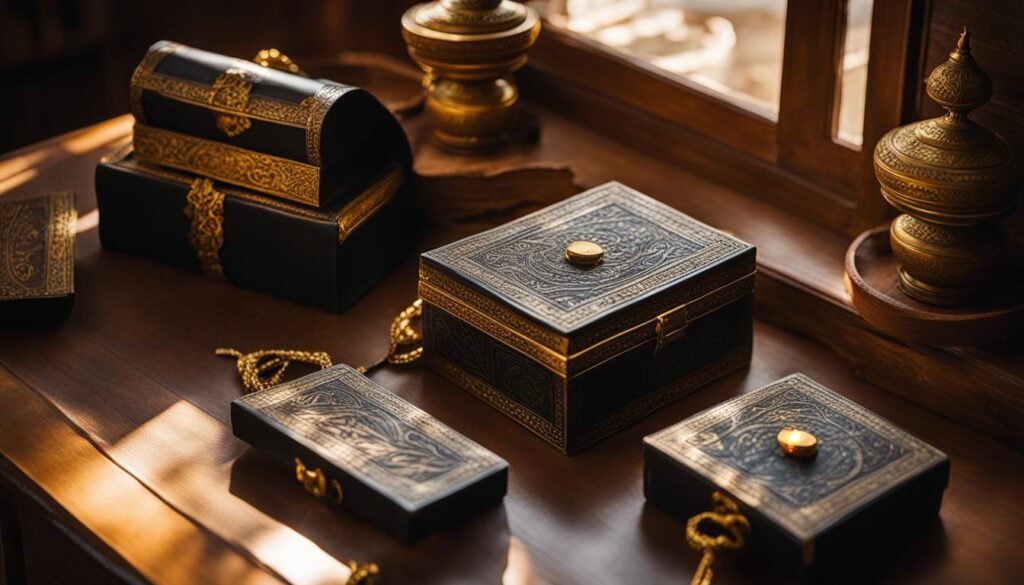
Lesser-Known Tools
In addition to the main components of Tefillin, there are lesser-known tools and accessories associated with this sacred Jewish tradition. These can include Tefillin bags for storage and protection, as well as decorative elements to personalize the Tefillin set.
While not as widely discussed, these additional tools enhance the overall experience of wearing and caring for Tefillin, adding layers of meaning and personal expression to this ancient ritual.
| Tool | Description |
|---|---|
| Tefillin Bag | A bag used to store and protect the Tefillin when not in use. It often features intricate embroidery or traditional Jewish motifs. |
| Tefillin Protective Cover | A cover used to shield the Tefillin boxes from dust and damage when not being worn. It is typically made from a durable material, such as leather or fabric. |
| Tefillin Decorative Elements | Various decorative elements, such as personalized nameplates or charms, can be added to the Tefillin straps to add individuality and personal meaning. |
Tefillin in Contemporary Judaism
In contemporary Judaism, Tefillin continues to be a cherished and relevant practice, serving as a tangible expression of Jewish identity and spirituality. This ancient tradition holds deep significance for many individuals, allowing them to connect with their faith in a profound way. The act of wearing Tefillin serves as a powerful reminder of one’s commitment to God and the commandments, fostering a sense of purpose and mindfulness in daily life.
While Tefillin remains rooted in tradition, there have been adaptations made to align with the values and practices of contemporary Jewish communities. Some individuals and communities have embraced more inclusive and flexible approaches to wearing Tefillin, allowing for a deeper personal connection and resonance. This reflects the dynamic nature of Jewish tradition, where the core principles are upheld while allowing for interpretations that meet the needs of each generation.
As Tefillin continues to be worn by individuals across the Jewish spectrum, it serves as a unifying symbol of Jewish identity. Regardless of variations among sects, the essence of Tefillin remains constant – it is a tangible expression of devotion, a physical reminder of the bond between God and the Jewish people, and a source of spiritual strength and guidance.
Key Points:
- Tefillin is a cherished practice in contemporary Judaism, connecting individuals with their faith and Jewish identity.
- Adaptations have been made to align with the values and practices of modern Jewish communities.
- Tefillin serves as a unifying symbol, regardless of variations among sects.
- It remains a powerful tool for spiritual strength and guidance in the fast-paced world of today.
Purchasing Phylacteries
When it comes to purchasing Tefillin, there are several important factors to consider. First and foremost, it is crucial to ensure that the phylacteries are kosher, meaning that they adhere to the strict religious guidelines set forth in Jewish law. Authenticity is key, as it connects the wearer to a rich tradition and ensures that the Tefillin are made with the utmost care and respect.
Trusted and knowledgeable sellers are essential when purchasing Tefillin. Seek out reputable sources who prioritize quality and authenticity. This will ensure that the materials used, such as the leather and ink, are of high quality and that the Tefillin boxes and straps display impeccable workmanship.

Additionally, it is important to consider the personal connection and resonance with the Tefillin. This is a deeply spiritual and meaningful practice, and finding Tefillin that feel like a meaningful addition to one’s religious practice is essential. Asking questions and seeking guidance from trusted individuals or communities who are well-versed in the nuances of Tefillin can be incredibly beneficial in finding Tefillin that align with one’s needs and spiritual aspirations.
By taking these factors into account, individuals can make an informed and meaningful choice when purchasing Tefillin, ensuring that this sacred item becomes an integral part of their spiritual journey.
Unique Lesser-Known Tools in Tefillin
In addition to the main components of Tefillin, there are unique and lesser-known tools and accessories associated with this sacred Jewish tradition. These additional tools may include Tefillin bags, protective covers, or decorative elements. While not as widely known or discussed, they can enhance the experience of wearing and caring for Tefillin. Exploring these lesser-known tools allows for a deeper understanding and appreciation of the complexities and richness of the Tefillin tradition.
One such accessory is the Tefillin bag, which serves as a protective case for the Tefillin when they are not being used. These bags come in various designs and materials. Some are made from velvet, while others feature intricate embroidery or have a simple and elegant design. The Tefillin bag not only safeguards the Tefillin but also adds a touch of reverence and beauty to the ritual. It is a way to keep the Tefillin organized and protected, ensuring their longevity.
Another lesser-known tool is the Tefillin cover. This cover is placed over the Tefillin boxes when they are worn on the arm and head. Similar to the Tefillin bag, the cover protects the boxes from wear and tear, preserving their sacredness. It can be made from fabric, leather, or other materials, often adorned with intricate designs or meaningful symbols. The Tefillin cover adds an extra layer of reverence and serves as a reminder of the spiritual significance of the Tefillin.
There are also decorative elements that can be added to the Tefillin straps. These elements, known as “beitzim,” are small decorative cases that are attached to the Tefillin straps. They come in various shapes and designs, often featuring Jewish symbols or inscriptions. While not essential to the functionality of the Tefillin, these decorative elements add a personal touch and can reflect the individual’s unique style and connection to their faith.
Exploring these unique and lesser-known tools in Tefillin allows for a deeper appreciation of the attention to detail and the beauty of this ancient Jewish tradition. These accessories not only enhance the ritual experience but also serve as visual reminders of the sacredness and significance of the Tefillin. They offer individuals the opportunity to personalize their Tefillin practice and make it a reflection of their own spiritual journey.
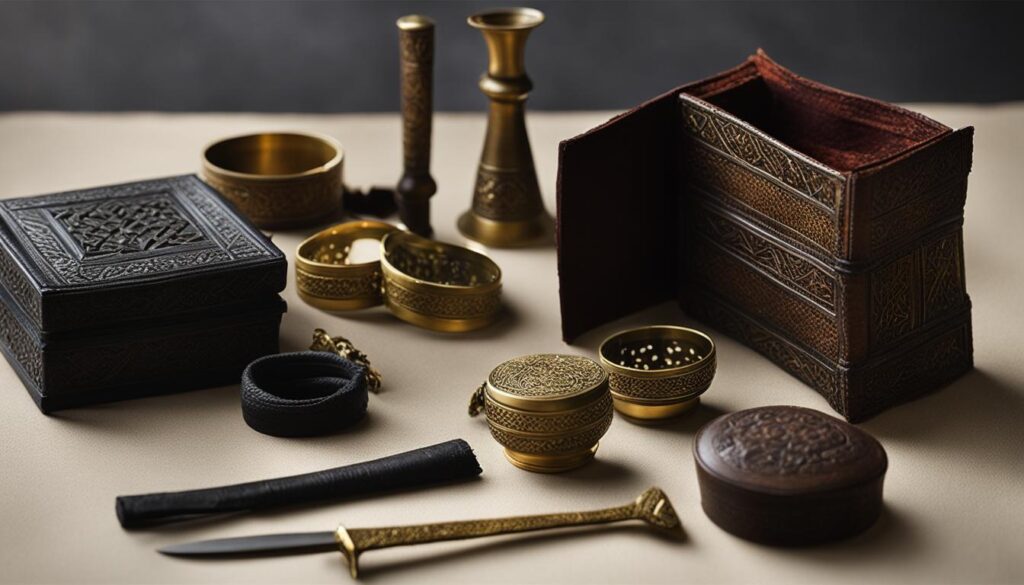
Are There Variations Among Sects in Tefillin?
Tefillin, being an essential Jewish ritual item, is subject to variations among different sects within the Jewish community. These variations may include differences in design, usage, or specific customs associated with wearing Tefillin. While the core purpose and significance of Tefillin remain consistent across all sects, the variations in practice and interpretation add depth and richness to this sacred tradition.
One notable variation among sects is in the arrangement of scriptural passages within the Tefillin boxes. The content of the scrolls may differ slightly, reflecting various traditions or interpretations within Judaism. Additionally, the crafting of the Tefillin boxes and straps may vary in terms of size, shape, or material used, reflecting the customs of different sects and communities.
Despite these variations, the fundamental principles and symbolism of Tefillin remain intact. Tefillin symbolize the binding of one’s actions and thoughts to God’s commandments, serving as a physical reminder of the spiritual connection between an individual and their faith. The variations among sects in the design and usage of Tefillin highlight the diverse and vibrant nature of Jewish practice.
Tefillin Variations Among Jewish Sects
The following table provides an overview of some key variations among Jewish sects in the design and usage of Tefillin:
| Sect | Variations |
|---|---|
| Orthodox | Strict adherence to specific guidelines for Tefillin construction and usage |
| Reform | Flexibility in design and usage, allowing for individual interpretation and adaptation |
| Conservative | Combination of traditional practices with some adaptations to align with modern values |
| Chasidic | Emphasis on intricate craftsmanship and attention to minute details in Tefillin construction |
“The variations in Tefillin design and usage among different Jewish sects showcase the diverse expressions of Jewish faith and the richness of interpretation within our tradition.” – Rabbi Cohen
While these variations exist, it is important to recognize that Tefillin, in all its forms, serves as a unifying symbol of Jewish identity and spirituality. Whether Orthodox, Reform, Conservative, or Chasidic, the practice of wearing Tefillin connects individuals to their heritage and demonstrates their commitment to the commandments and teachings of Judaism.
How Have Tefillin Changed Over Time?
Tefillin, as sacred ritual items, have undergone significant changes in design over time while maintaining their spiritual and symbolic value. These changes reflect historical shifts and developments within the Jewish community, adapting to the needs and customs of each generation. By understanding the evolution of Tefillin, we gain insight into the dynamic nature of Jewish rituals and the ways in which tradition can be reimagined and revitalized.
The design changes in Tefillin can be observed in multiple aspects. Historically, there have been variations in the arrangement of scriptural passages, reflecting the diversity of Jewish interpretation and practice. Additionally, craftsmanship techniques and materials have evolved, with artisans incorporating new methods and styles while adhering to the religious standards that govern their creation.
One notable change in Tefillin design is the introduction of decorative elements. While the focus remains on the spiritual significance, artisans now incorporate ornamental details and intricate patterns into the boxes and straps, adding aesthetic beauty to these sacred objects. This evolution in design not only showcases the creativity and skill of craftsmen but also allows individuals to connect with Tefillin in a more personal and meaningful way.
The Evolution of Tefillin Design
| Era | Design Changes | Significance |
|---|---|---|
| Antiquity | Simple leather boxes and straps | The foundational design of Tefillin, emphasizing purity and tradition |
| Middle Ages | Introduction of intricate embroidery and decorative motifs | Enhanced visual appeal while maintaining focus on spiritual connection |
| Modern Era | Integration of innovative materials, such as synthetic leather | Addressing practical concerns while preserving the sanctity of Tefillin |
It is important to note that while design changes have occurred, the fundamental purpose and significance of Tefillin remain unaltered. They continue to serve as a physical reminder of the commitment to God and the preservation of Jewish identity, regardless of the specific design or adornments.

The Significance of Tefillin in Jewish Tradition
Tefillin, also known as Phylacteries, hold a deep significance in Jewish tradition, serving as a physical embodiment of the commitment to God’s commandments and the strength of Jewish identity. These sacred tools are not just accessories; they are powerful instruments for enriching one’s religious practice and strengthening their connection with their faith and heritage.
The act of wearing Tefillin is seen as an act of love and dedication, binding individuals to the will of God and fostering a union with the Almighty. The black boxes containing scriptures serve as a constant reminder of God’s commandments, guiding individuals on their spiritual journey. When worn during prayers, Tefillin enhance the experience, allowing for a more profound connection with God and fostering mindfulness in worship.
While the essence and spiritual significance of Tefillin remain constant, there may be variations in their design and usage among different Jewish sects. Each community may have its own customs and interpretations associated with Tefillin, showcasing the diversity within the Jewish tradition. Nevertheless, the enduring presence of Tefillin throughout Jewish history, even in times of adversity, showcases their significance and the steadfastness of Jewish devotion.
| Materials | Symbolism | Variations | Changes Over Time |
|---|---|---|---|
| Leather | Connection with faith | Design and usage | Adaptation to reflect historical shifts |
| Ink | Written words of God | Customs and interpretations | Maintaining spiritual and symbolic value |
| Parchment | Reminder of commandments | Interpretation within sects | Preserving essence amidst design changes |
As Judaism continues to evolve, Tefillin remain a symbol of deep-rooted tradition and spiritual practice. By donning Tefillin, individuals can engage in a ritual that connects them with centuries of Jewish heritage and allows them to express their devotion to God. Whether through the act of wearing or the craftsmanship behind their creation, Tefillin serve as a testament to the enduring significance of Jewish practice and the strength of faith.
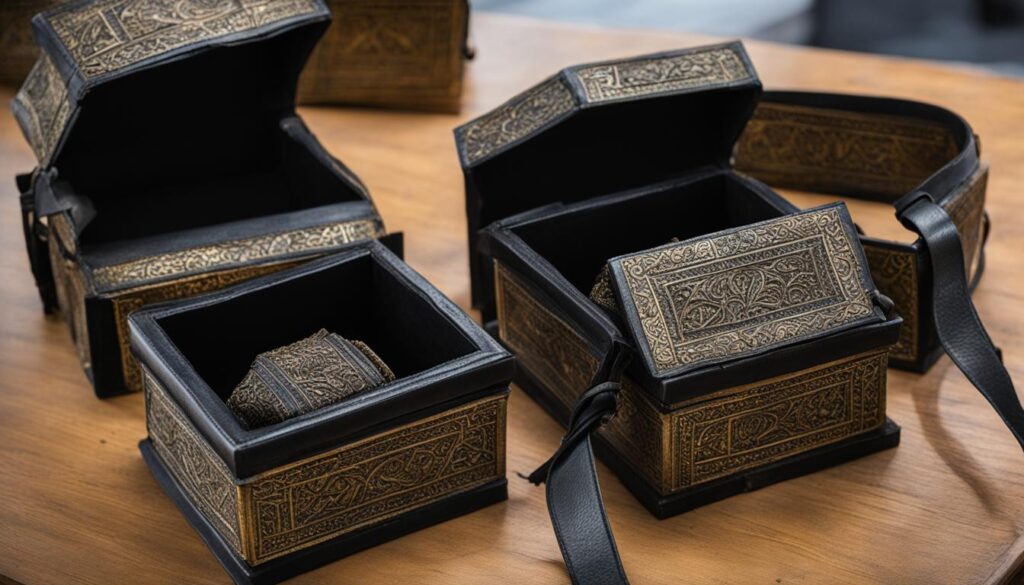
Conclusion
Embracing the tradition of wearing Tefillin is a meaningful practice that brings individuals closer to their spiritual core and fosters a deeper connection with their faith and Jewish heritage. The significance and symbolism of Tefillin make them not just accessories but powerful tools for enriching one’s religious practice and strengthening their Jewish identity.
Wearing Tefillin during prayer is a way to bind one’s actions and thoughts to God, symbolizing a commitment to His teachings and commandments. It serves as a reminder of one’s obligations and deepens the sense of devotion during worship. The act of donning Tefillin transforms prayers into profound spiritual experiences, enhancing the connection with God and fostering mindfulness.
While the essence and spiritual significance of Tefillin remain constant, there may be variations among different Jewish sects in terms of design and usage. These variations reflect the diversity within the Jewish community and the unique interpretations of this sacred tradition. However, regardless of the variations, Tefillin continue to serve as a powerful symbol in contemporary Judaism, preserving traditions and anchoring Jewish identity in an ever-changing world.
As individuals embark on their spiritual journey, considering the purchase of Tefillin can be a significant step in deepening their religious practice. Seeking kosher phylacteries crafted with meticulous artistry and quality materials ensures their sacred value. Exploring lesser-known tools and accessories associated with Tefillin allows for a more comprehensive understanding and appreciation of this rich tradition. Embrace the tradition of Tefillin, and let it guide you on your spiritual path.
FAQ
What are Tefillin?
Tefillin, also known as Phylacteries, are small black boxes paired with leather straps that hold deep spiritual significance in Judaism.
How are Tefillin worn?
Tefillin are worn on the arm and forehead during weekday morning prayers.
What do Tefillin symbolize?
Tefillin symbolize the binding of one’s actions and thoughts to God and His teachings.
What are the boxes and straps made of?
The boxes, known as batim, are made of black leather. The straps, called retzuot, are also made of black leather.
What is enclosed in the Tefillin boxes?
Scrolls with passages from the Torah are enclosed in each box.
What is the significance of wearing Tefillin during prayers?
Wearing Tefillin enhances one’s spiritual practice, serving as a powerful reminder of God’s presence and fostering a more mindful and dedicated approach to worship.
How have Tefillin evolved over time?
Tefillin have undergone design changes and adaptations but still maintain their spiritual and symbolic value.
How can one purchase authentic Tefillin?
It is essential to seek trusted and knowledgeable sellers who prioritize quality and authenticity.
Are there variations in the design and usage of Tefillin?
Yes, different Jewish sects may have variations in the arrangement of scriptural passages and customs associated with wearing Tefillin.
What is the significance of Tefillin in Jewish tradition?
Tefillin serve as a physical embodiment of the commitment to God’s commandments and the strength of Jewish identity.


